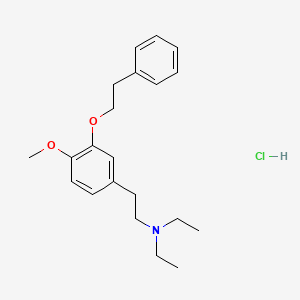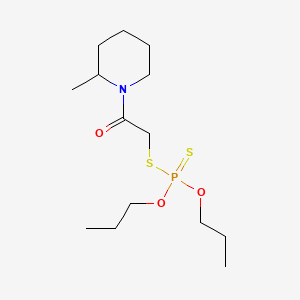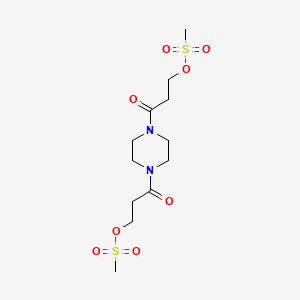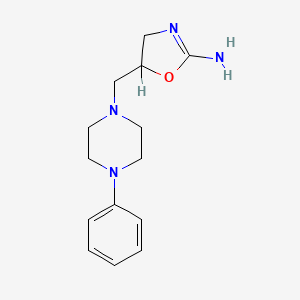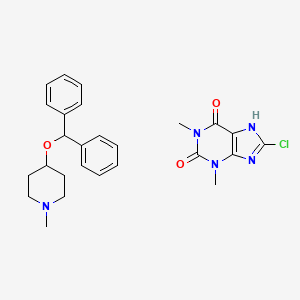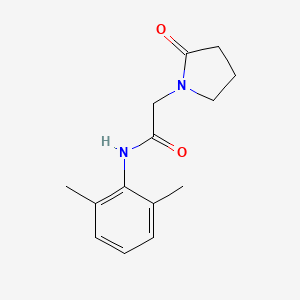
尼非地平
概述
描述
尼非拉塞坦是一种属于吡咯烷酮类家族的促智化合物。它于 1990 年代由大日本住友制药在东京首次开发。尼非拉塞坦以其认知增强特性而闻名,包括改善记忆力、情绪和动机。 它是吡拉西坦的衍生物,具有相似的化学结构,但其胺基上增加了苯基和两个甲基,这使其与其他吡咯烷酮相比具有更高的效力 .
科学研究应用
Nefiracetam has a wide range of scientific research applications:
Chemistry: Used as a model compound for studying racetam derivatives and their chemical properties.
Biology: Investigated for its effects on neuronal signaling and neuroprotection.
Medicine: Studied for its potential in treating cognitive impairments, Alzheimer’s disease, and post-stroke recovery.
Industry: Utilized in the development of cognitive-enhancing supplements and pharmaceuticals
作用机制
尼非拉塞坦通过多种机制发挥作用:
GABA 系统: 通过调节 GABA 受体来增强 GABAergic 信号传导。
胆碱能系统: 通过增强烟碱型乙酰胆碱受体来提高乙酰胆碱水平。
单胺能系统: 调节多巴胺和血清素等单胺类神经递质。
生化分析
Biochemical Properties
Nefiracetam interacts with various enzymes, proteins, and other biomolecules. It shows high affinity for the GABA A receptor, where it is presumed to be an agonist . It enhances both GABAergic and cholinergic signalling . It also exhibits antiamnesic effects against a number of memory impairing substances .
Cellular Effects
Nefiracetam has significant effects on various types of cells and cellular processes. It influences cell function by enhancing signalling of acetylcholine and glutamate at the synapse and then prolonging the calcium in the activated neuron . It also modulates the GABAA receptor-channel, playing a significant role in reducing neuronal excitability throughout the nervous system .
Molecular Mechanism
Nefiracetam exerts its effects at the molecular level through several mechanisms. It prolongs the opening of calcium channels, which enhances signalling of a receptor independent of the synapse . It also augments signalling through cholinergic receptors, which then releases most excitatory neurotransmitters from the presynaptic level .
Temporal Effects in Laboratory Settings
In laboratory settings, the effects of Nefiracetam change over time. It does not appear to significantly affect memory formation acutely, but it can increase memory formation when taken daily over a prolonged period of time . It also shows a higher rate of neurogenesis with prolonged supplementation .
Dosage Effects in Animal Models
In animal models, the effects of Nefiracetam vary with different dosages. Animal studies using acute doses tend to note most benefits in the 3-10mg/kg range . This range has been repeatedly shown to enhance memory formation when taken daily over a prolonged period of time .
Metabolic Pathways
Nefiracetam is involved in various metabolic pathways. It is extensively metabolised, and its major metabolites in humans are 5-hydroxy-nefiracetam, 4-hydroxy-nefiracetam and N-[(2,6-dimethylphenylcarbamoyl)methyl]-succinamic acid .
准备方法
合成路线和反应条件: 尼非拉塞坦可以通过多步合成工艺合成,该工艺涉及 2,6-二甲基苯胺与氯乙酸乙酯反应形成中间体,然后环化生成尼非拉塞坦。 反应条件通常涉及使用乙醇等溶剂和乙醇钠等催化剂 .
工业生产方法: 尼非拉塞坦的工业生产涉及类似的合成路线,但规模更大。 该工艺针对更高的产量和纯度进行了优化,通常会涉及额外的纯化步骤,如重结晶和色谱,以确保最终产品符合医药标准 .
化学反应分析
反应类型: 尼非拉塞坦会发生各种化学反应,包括:
氧化: 尼非拉塞坦可以被氧化生成羟基化衍生物。
还原: 还原反应可以将尼非拉塞坦转化为其相应的胺。
常用试剂和条件:
氧化: 常用的氧化剂包括高锰酸钾和过氧化氢。
还原: 使用锂铝氢化物和硼氢化钠等还原剂。
取代: 常用亲核试剂如叠氮化钠和硫醇.
主要产物:
氧化: 羟基化尼非拉塞坦衍生物。
还原: 胺化尼非拉塞坦衍生物。
4. 科研应用
尼非拉塞坦具有广泛的科研应用:
化学: 用作研究吡咯烷酮衍生物及其化学性质的模型化合物。
生物学: 研究其对神经元信号传导和神经保护的作用。
医药: 研究其在治疗认知障碍、阿尔茨海默病和中风后恢复方面的潜力。
工业: 用于开发认知增强补充剂和药物
相似化合物的比较
尼非拉塞坦与其他吡咯烷酮类化合物进行比较,例如:
吡拉西坦: 第一个吡咯烷酮类化合物,以其认知增强作用而闻名,但效力低于尼非拉塞坦。
阿尼拉西坦: 与尼非拉塞坦相似,但具有额外的抗焦虑特性。
奥拉西坦: 以其刺激作用和认知增强作用而闻名。
苯吡拉西坦: 比吡拉西坦更有效,具有额外的兴奋剂特性。
普拉米拉西坦: 效力很高,主要用于增强记忆力
尼非拉塞坦因其独特的认知增强、神经保护和情绪改善相结合而脱颖而出,使其成为吡咯烷酮类家族中的一种通用化合物。
属性
IUPAC Name |
N-(2,6-dimethylphenyl)-2-(2-oxopyrrolidin-1-yl)acetamide | |
|---|---|---|
| Source | PubChem | |
| URL | https://pubchem.ncbi.nlm.nih.gov | |
| Description | Data deposited in or computed by PubChem | |
InChI |
InChI=1S/C14H18N2O2/c1-10-5-3-6-11(2)14(10)15-12(17)9-16-8-4-7-13(16)18/h3,5-6H,4,7-9H2,1-2H3,(H,15,17) | |
| Source | PubChem | |
| URL | https://pubchem.ncbi.nlm.nih.gov | |
| Description | Data deposited in or computed by PubChem | |
InChI Key |
NGHTXZCKLWZPGK-UHFFFAOYSA-N | |
| Source | PubChem | |
| URL | https://pubchem.ncbi.nlm.nih.gov | |
| Description | Data deposited in or computed by PubChem | |
Canonical SMILES |
CC1=C(C(=CC=C1)C)NC(=O)CN2CCCC2=O | |
| Source | PubChem | |
| URL | https://pubchem.ncbi.nlm.nih.gov | |
| Description | Data deposited in or computed by PubChem | |
Molecular Formula |
C14H18N2O2 | |
| Source | PubChem | |
| URL | https://pubchem.ncbi.nlm.nih.gov | |
| Description | Data deposited in or computed by PubChem | |
DSSTOX Substance ID |
DTXSID2020923 | |
| Record name | Nefiracetam | |
| Source | EPA DSSTox | |
| URL | https://comptox.epa.gov/dashboard/DTXSID2020923 | |
| Description | DSSTox provides a high quality public chemistry resource for supporting improved predictive toxicology. | |
Molecular Weight |
246.30 g/mol | |
| Source | PubChem | |
| URL | https://pubchem.ncbi.nlm.nih.gov | |
| Description | Data deposited in or computed by PubChem | |
CAS No. |
77191-36-7 | |
| Record name | Nefiracetam | |
| Source | CAS Common Chemistry | |
| URL | https://commonchemistry.cas.org/detail?cas_rn=77191-36-7 | |
| Description | CAS Common Chemistry is an open community resource for accessing chemical information. Nearly 500,000 chemical substances from CAS REGISTRY cover areas of community interest, including common and frequently regulated chemicals, and those relevant to high school and undergraduate chemistry classes. This chemical information, curated by our expert scientists, is provided in alignment with our mission as a division of the American Chemical Society. | |
| Explanation | The data from CAS Common Chemistry is provided under a CC-BY-NC 4.0 license, unless otherwise stated. | |
| Record name | Nefiracetam [INN] | |
| Source | ChemIDplus | |
| URL | https://pubchem.ncbi.nlm.nih.gov/substance/?source=chemidplus&sourceid=0077191367 | |
| Description | ChemIDplus is a free, web search system that provides access to the structure and nomenclature authority files used for the identification of chemical substances cited in National Library of Medicine (NLM) databases, including the TOXNET system. | |
| Record name | Nefiracetam | |
| Source | DrugBank | |
| URL | https://www.drugbank.ca/drugs/DB13082 | |
| Description | The DrugBank database is a unique bioinformatics and cheminformatics resource that combines detailed drug (i.e. chemical, pharmacological and pharmaceutical) data with comprehensive drug target (i.e. sequence, structure, and pathway) information. | |
| Explanation | Creative Common's Attribution-NonCommercial 4.0 International License (http://creativecommons.org/licenses/by-nc/4.0/legalcode) | |
| Record name | Nefiracetam | |
| Source | DTP/NCI | |
| URL | https://dtp.cancer.gov/dtpstandard/servlet/dwindex?searchtype=NSC&outputformat=html&searchlist=759830 | |
| Description | The NCI Development Therapeutics Program (DTP) provides services and resources to the academic and private-sector research communities worldwide to facilitate the discovery and development of new cancer therapeutic agents. | |
| Explanation | Unless otherwise indicated, all text within NCI products is free of copyright and may be reused without our permission. Credit the National Cancer Institute as the source. | |
| Record name | Nefiracetam | |
| Source | EPA DSSTox | |
| URL | https://comptox.epa.gov/dashboard/DTXSID2020923 | |
| Description | DSSTox provides a high quality public chemistry resource for supporting improved predictive toxicology. | |
| Record name | N-(2,6-dimethylphenyl)-2-(2-oxopyrrolidin-1-yl)acetamide | |
| Source | European Chemicals Agency (ECHA) | |
| URL | https://echa.europa.eu/information-on-chemicals | |
| Description | The European Chemicals Agency (ECHA) is an agency of the European Union which is the driving force among regulatory authorities in implementing the EU's groundbreaking chemicals legislation for the benefit of human health and the environment as well as for innovation and competitiveness. | |
| Explanation | Use of the information, documents and data from the ECHA website is subject to the terms and conditions of this Legal Notice, and subject to other binding limitations provided for under applicable law, the information, documents and data made available on the ECHA website may be reproduced, distributed and/or used, totally or in part, for non-commercial purposes provided that ECHA is acknowledged as the source: "Source: European Chemicals Agency, http://echa.europa.eu/". Such acknowledgement must be included in each copy of the material. ECHA permits and encourages organisations and individuals to create links to the ECHA website under the following cumulative conditions: Links can only be made to webpages that provide a link to the Legal Notice page. | |
| Record name | NEFIRACETAM | |
| Source | FDA Global Substance Registration System (GSRS) | |
| URL | https://gsrs.ncats.nih.gov/ginas/app/beta/substances/1JK12GX30N | |
| Description | The FDA Global Substance Registration System (GSRS) enables the efficient and accurate exchange of information on what substances are in regulated products. Instead of relying on names, which vary across regulatory domains, countries, and regions, the GSRS knowledge base makes it possible for substances to be defined by standardized, scientific descriptions. | |
| Explanation | Unless otherwise noted, the contents of the FDA website (www.fda.gov), both text and graphics, are not copyrighted. They are in the public domain and may be republished, reprinted and otherwise used freely by anyone without the need to obtain permission from FDA. Credit to the U.S. Food and Drug Administration as the source is appreciated but not required. | |
Synthesis routes and methods I
Procedure details








Synthesis routes and methods II
Procedure details







Synthesis routes and methods III
Procedure details







Retrosynthesis Analysis
AI-Powered Synthesis Planning: Our tool employs the Template_relevance Pistachio, Template_relevance Bkms_metabolic, Template_relevance Pistachio_ringbreaker, Template_relevance Reaxys, Template_relevance Reaxys_biocatalysis model, leveraging a vast database of chemical reactions to predict feasible synthetic routes.
One-Step Synthesis Focus: Specifically designed for one-step synthesis, it provides concise and direct routes for your target compounds, streamlining the synthesis process.
Accurate Predictions: Utilizing the extensive PISTACHIO, BKMS_METABOLIC, PISTACHIO_RINGBREAKER, REAXYS, REAXYS_BIOCATALYSIS database, our tool offers high-accuracy predictions, reflecting the latest in chemical research and data.
Strategy Settings
| Precursor scoring | Relevance Heuristic |
|---|---|
| Min. plausibility | 0.01 |
| Model | Template_relevance |
| Template Set | Pistachio/Bkms_metabolic/Pistachio_ringbreaker/Reaxys/Reaxys_biocatalysis |
| Top-N result to add to graph | 6 |
Feasible Synthetic Routes
体外研究产品的免责声明和信息
请注意,BenchChem 上展示的所有文章和产品信息仅供信息参考。 BenchChem 上可购买的产品专为体外研究设计,这些研究在生物体外进行。体外研究,源自拉丁语 "in glass",涉及在受控实验室环境中使用细胞或组织进行的实验。重要的是要注意,这些产品没有被归类为药物或药品,他们没有得到 FDA 的批准,用于预防、治疗或治愈任何医疗状况、疾病或疾病。我们必须强调,将这些产品以任何形式引入人类或动物的身体都是法律严格禁止的。遵守这些指南对确保研究和实验的法律和道德标准的符合性至关重要。
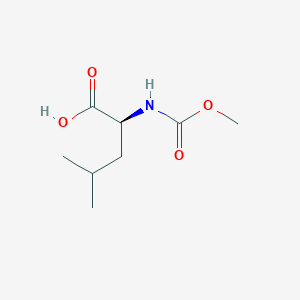

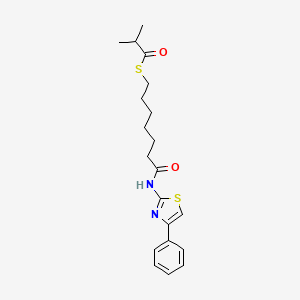
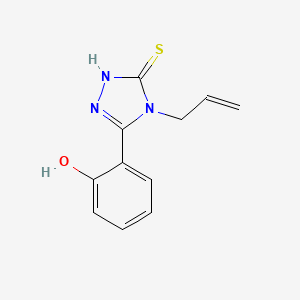
![4-[(3-bromobenzyl)amino]-4H-1,2,4-triazol-3-yl hydrosulfide](/img/structure/B1677937.png)

